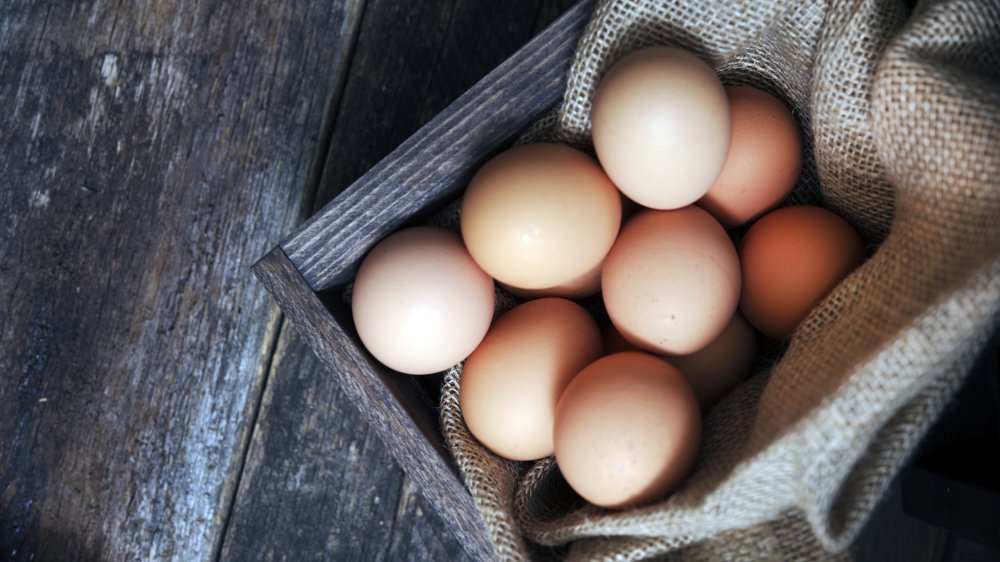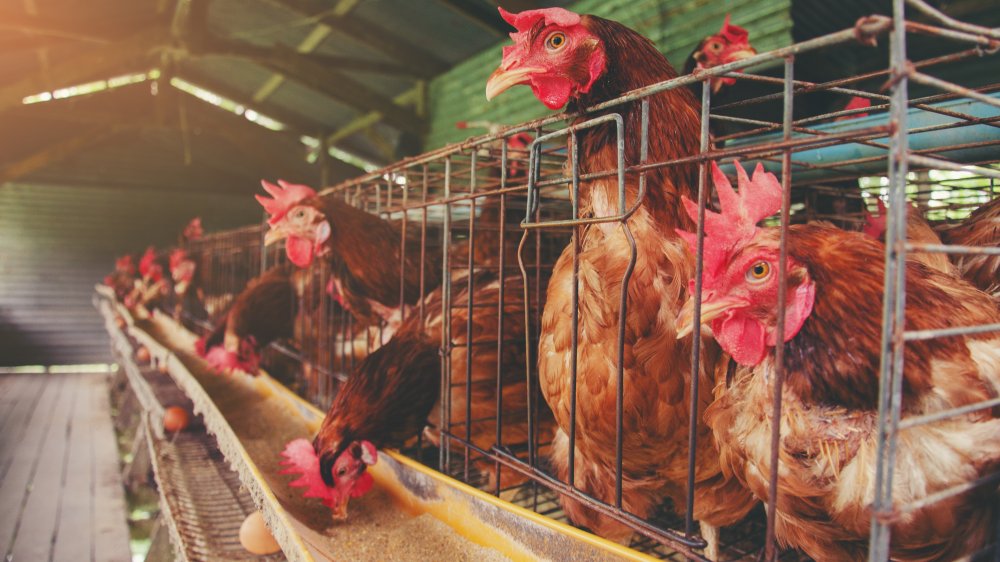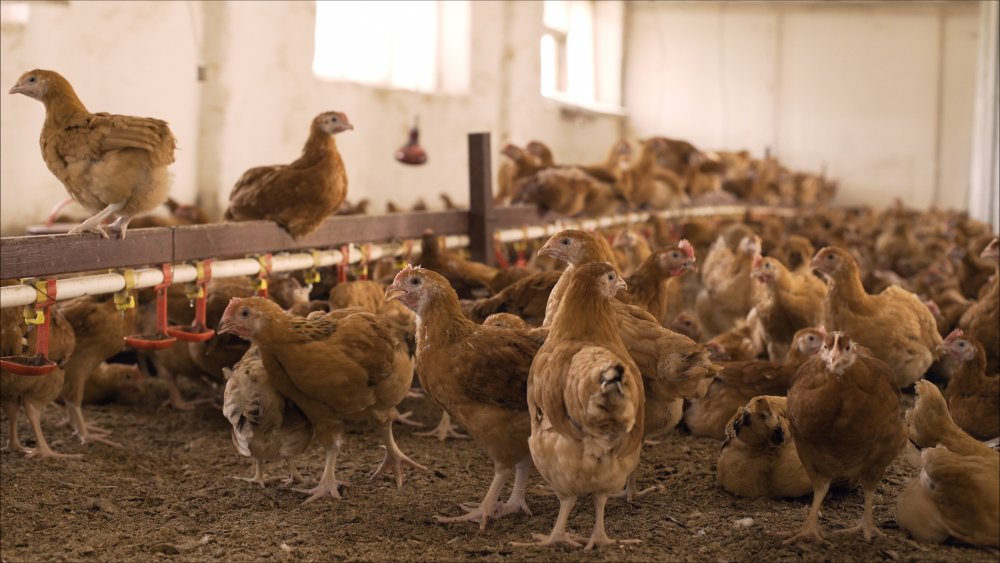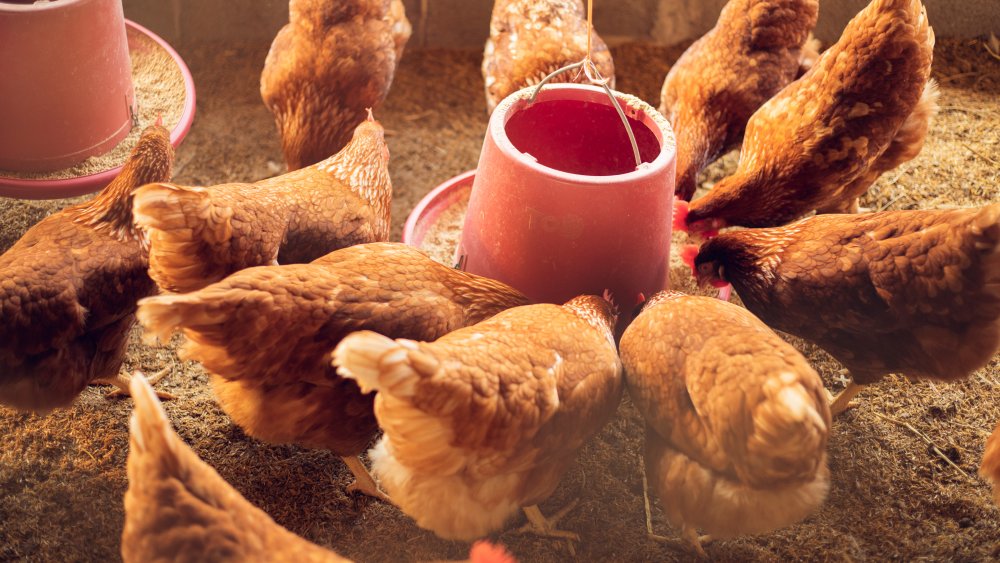The Real Reason You Should Be Eating Cage-Free Eggs
Eggs come with many labels, from generic grocery store eggs to cage-free eggs, and from free-range to grass-fed eggs. The best eggs to buy are cage-free, though grass-fed or organic cage-free will have similar health benefits, as the main difference is in the life of the chicken.
The production of eggs, as a rule, does not have the interests of the chickens in mind. As a result, most chickens are raised in ways that most would not consider humane.
Factory farms are the worst for chickens (via Eating Well). Hens are in battery cages that are around the size of a microwave that smell of ammonia, and they're crowded in wing-to-wing with five or so other hens. Food belts roll past, requiring the hens to stick their heads out of the cages to get food. The hens stand in their cages all day long. They defecate through a wire floor that removes the waste, and they don't have room to move around much or fully spread their wings. Hens usually dust-bathe to work dirt through their feathers, but they don't have the space to do that here, either. Through their short life span, hens' bones begin to get brittle from lack of movement and their feathers will rub off from chafing on the sides of the cage. When a hen is about 78 weeks old, she will be what poultry producers call "depopulated" to make room for a new batch of chickens.
The life of a factory chicken
Approximately 97 percent of egg-laying hens in the United States are raised in these small cages. The United Egg Producers (UEP) minimum standards, which are minimum indeed, require each chicken to have 67 square inches, a dimension smaller than a standard piece of notebook paper. Even more worrying, the UEP estimates approximately 15 percent of hens are raised by farmers who don't even meet those standards (via Vox).
Being cooped up (not a pun, just appropriate use of the phrase) in that small space causes major disruption to the egg-laying process. Hens usually lay eggs in an area where they have some privacy. "The worst torture to which a battery hen is exposed is the inability to retire somewhere for the laying act," said Konrad Lorenz, a Nobel Laureate ethologist (someone who studies animal behavior). "It is truly heart-rending to watch how a chicken tries again and again to crawl beneath her fellow cagemates to search there in vain for cover."
There are three other types of cages that farmers can use instead of these restrictive ones: aviary systems, barn systems, and "enriched cages." The aviary system provides 144 square inches of floor space per hen, or 240 inches of combined floor and tier. The hens are kept in multiple tiers in an area filled with nests, sawdust, and litter. They are held in large groups, regardless of whether it is a free-range facility.
The differences in farming styles
Barn systems give each hen 200 square inches of floor space but still have nests, litter, and sawdust with large groups of hens. Other than the additional 56 square inches of floor space, the other main addition is perches.
The enriched cage system provides each hen 116 square inches. The hens are kept in small groups with a nesting area, a dust bathing area, and perches.
Aviary systems and barn systems may provide access to the outdoors, making them "free range," according to the label in the grocery store. In the United States, the producers of organic eggs are required to provide outdoor access to the chickens.
Cage-free hens, though, can walk, spread their wings, and lay their eggs in nests — activities denied to hens in battery cages. Cage-free hens usually live in large flocks of thousands of hens. However, they still likely never go outside. Most cage-free hens live on farms certified by a third party, which requires perches and dust-bathing areas for the hens (via Humane Society).
Cage-free eggs have less risk of disease
The label "organic" may carry some baggage with it as well. Organic producers aren't allowed to provide synthetic amino acids that improve the health of the chickens. They are also restricted in their antibiotic use. Farmers can't treat sick animals with antibiotics and then sell them as organic. This frequently results in farmers not treating sick chickens, leaving the hens to suffer.
Moving past the humane issue, there are major safety concerns with eggs laid by chickens that are not cage-free. The European Food Safety Authority found that salmonella is five times more likely to be present in cage systems compared to free-range systems. The reason for the decreased risk with cage-free systems is most likely because of a combination of the cage-free systems being cleaner, having fewer rodents that could be carrying diseases, the systems themselves are easier to clean and disinfect, the hens have a more natural gut flora, and they are less stressed, making them less susceptible to illness. The eggs from these chickens also have lower levels of chemical residue from insecticides and a lower concentration of dioxin-like contaminants, as well as fewer insect infestations (via The Poultry Site).
You should eat cage-free eggs. They are likely to be healthier and safer, and the hens have a more pleasant, humane life.



